MetaAmerica Project Introduction
 This is a conceptual design for a macroeconomics development project for the Binational region that includes Sonora, Mexico, Arizona, USA, and parts of California, USA, and Baja, California in Mexico. All of these areas face the Gulf of California (the Sea of Cortez), which is the focus of this development proposal.
This is a conceptual design for a macroeconomics development project for the Binational region that includes Sonora, Mexico, Arizona, USA, and parts of California, USA, and Baja, California in Mexico. All of these areas face the Gulf of California (the Sea of Cortez), which is the focus of this development proposal.
Conceived as a forty-year project to turn the region into a haven for high technology and space science that can serve as The Americas Space Science Development District, the area’s potential is presently untapped for good reasons.
This conceptual plan suggests that a group of technologies and projects can, in combination, serve to use this region to move the Americas toward the peaceful and prosperous integration of space into the economy.
The project’s keystone is the SpaceHarbor complex that can be built in Central Arizona. This idea seeks to leverage the success of Arizona’s premier air facility, Phoenix Sky Harbor International Airport. The long history of success at PSHIA can be extended into developing a civilian spaceport northwest of Casa Grande, Arizona.
This area has abundant land and an unusually high number of cloudless days. Located between Phoenix and Tucson on the international rail line, it has an almost level path to the coast of the Gulf of California.
A transportation corridor from SpaceHarbor to Puerto Penasco will need to overcome numerous legal impediments caused by right-of-way issues and the fact that it will cross an international border. The actual construction of a means of transportation is probably the easiest part of this project.
Conventional rail or highway construction will be appropriate, but a more modern system can also be considered. The Azora Community Rail is a design that can serve as an interurban backbone transit system for the region with many advantages.
The Puerto Penasco area has broad white sand beaches that have attracted development for many years. Each development has overcome the area’s limitations independently, primarily the shortage of fresh water. An economic development district to address the growth issues will be needed. The area’s environment is fragile and very related to the tides that form a complex estuarial ecosystem, which will require special consideration to preserve. The seasonal extremes of the tides are as great as anywhere in the world, annually exceeding fifty feet. The resulting expansive beaches are an entertaining stroll, so long as you stay close to higher ground. West of Puerto Penasco, the shallow sea has been declared a refuge for rare aquatic mammals and other sea life. The lack of fresh water, tidal range, and environmental sensitivity of the northern gulf have inhibited development for good reasons, but a macroeconomic approach can solve these problems.
Docking any but the small craft is difficult in the northern gulf. Puerto Penasco is a rocky promontory that juts out to create a small but usable harbor for small fishing vessels, and shrimp and prawns provide a small industry for local fishermen. Their craft is small, seldom exceeding forty feet, but adequate for the purpose. Expansion of the harbor is not environmentally wise according to authorities because it would require dredging not only the harbor but a channel that would extend for over twenty kilometers (see map above) to consistently deep water.
The solution to the harbor problem has been in operation in the English Channel for many years. Hovercraft ferries have operated between England and France for a long time, but the best model for hovercraft operation in this area is the military. Shore landing strategies have for many years used shallow draft ships with flood decks to launch hovercraft and landing of troops and supplies on beaches. A civilian version of this technology is the answer for the Gulf of California. The ship is conceived as a floating port, a catamaran or multi-hull design with a large flood deck aft and roll-on-roll-off doors on either side for ferrying cars, trucks, and recreational vehicles. Storage for warehousing and areas for offices, medical services, and luxury accommodations for passengers can be part of each vessel, each Cortez Coastal Carrier. A fleet of such carriers can circulate around the gulf so that one passes every port daily. Hovercraft can be based onshore or on a carrier to ferry goods and passengers to or from the shore. Each carrier and hovercraft can have a cellular communications array to maintain linkages to shore and each other while enabling passengers easy access to communications.
The extent of the development proposed here will require substantial supplies of fresh water, energy, and local foods. The financial viability of the area depends on having these resources at reasonable and stable prices. The source of these supplies is an anomaly in the shallow gulf, a three thousand-foot deep-sea canyon that can host a land-based version of the much-storied Ocean Thermal Electric Conversion (OTEC) power plant. These plants usually require a substantial difference, about forty degrees, between the deep water and the warm upper water to operate the evaporation and condensation cycles. This requirement can be met with either surface water or solar ponds adjacent to the land-based facility. Additionally, it is notable that the region is prime solar energy land and can support a variety of solar energy complexes to generate power.
The OTECs offer a sustainable source of fresh water, electric power, and aquaculture. They are the economic foundation for a large and stable population to inhabit the shores of the Gulf of California. Attracting premium employment opportunities and the lifestyle that goes with those types of jobs are addressed by the high-technology businesses needed to for the emerging space manufacturing sector and the fusion of cultures such broad-based enterprises create. The region’s position on the boundary between English-speaking North America and the Latin cultures of South America is further complemented by its exposure to Pacific Rim trade contacts. A macroeconomic plan for the region that includes all of these elements will be successful.
Strategic issues associated with implementing any or all of these projects will require the efforts of nations and global entities such as the World Bank and the United Nations. Still, it is the type of project that should interest all of these. World events will determine when they can turn their attention to projects of this scope.
The Sea of Cortez will be waiting.
MetaAmerica Projects
A New Central Arizona Space Port for Regional Freight exchange with off-world Producers.
Concept Statement
This concept includes:
- The development of international space and airport (freight and passengers) to serve the space/aviation needs of the southwestern United States and northwestern Mexico;
- The development of adequate facilities for the Arizona National Guard and Air Force;
- The provision of landing facilities for the Space Shuttle and similar Spacefreight Shuttles
- The development of a linear transportation corridor utilizing high-speed rail technology to link each major metropolitan area with the international space/airport with a portal to the portal time of fewer than forty minutes;
- The development of a multi-modal freight transportation hub;
- Support for developing an international aerospace high-technology/electronic industrial park, including a free trade zone adjacent to the international space/airport.
The international space/airport would be planned and designed to potentially accommodate the existing Marana army operations and Tucson Air National Guard activities as well. It is anticipated that the development of this space/airport (henceforth referred to as the SpaceHarbor or SH) will be evolutionary, and its role will be to supplement Phoenix Sky Harbor International Airport and Tucson International Airports. The SH will not compete with these airports. It will focus on Space industries and related development opportunities and seek out only those airlines and air travel markets that are not attractive to these two airports. Initially SpaceHarbor will focus on multi-modal freight movement and the industrial development near the site.
Arizora Community Rail
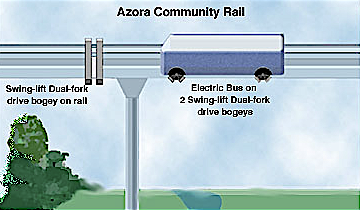 The ArizoraCR proposal offers a number of advantages for transportation planning. A single beam provides bi-directional transit as well as a utility duct for power and communications.
The ArizoraCR proposal offers a number of advantages for transportation planning. A single beam provides bi-directional transit as well as a utility duct for power and communications.
In a concept derived from the Owen Transportation Group, Inc. system, Electric motor-driven bogeys with swing-lift forks that use steel wheels to ride on the side of the beam enable a flexible system that can be adapted to haul dedicated passenger cabins and freight containers into urban terminals or transport electric wheeled vehicles to suburban transit stations.
Additionally, the use of the independent bogies enables the movement of these key transit units in an unloaded condition, allowing them to be transferred between locations with a minimum of cost and inconvenience.
Moving freight containers between urban terminals can offer an additional utility for the system during low-use times.
Safety and service issues are addressed by using independently powered utility support vehicles that can rescue stranded passengers or haul service personnel and supplies for utility ductwork or bogey field repairs.
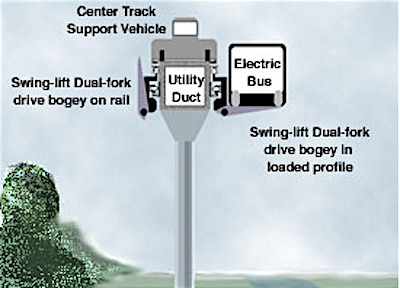 Elevated systems have many advantages, while the disadvantages are greatly reduced with this design.
Elevated systems have many advantages, while the disadvantages are greatly reduced with this design.
Low environmental impact combines with greatly reduced right-of-way acquisition cost and minimized construction disruption to offer a system that can be built quickly without unnecessary intrusion into the lives of citizens.
The illustration below and on the left has the ACR corridor combined with a riparian park system. This is one of the methods to take advantage of the elevated systems’ quiet and environmentally friendly design.
Creating a low visual impact profile against the skyline is one benefit of the side-mounted rail. Integrating a bogey-mounted active noise cancellation system will make their movement whisper quiet. In environmentally sensitive areas, the elevated and side-mounted transit units are safer for both land and airborne animals, while noise suppression technology reduces auditory disturbance. Electric power from the beam-integrated rail can be used to charge the batteries of the specially-built buses.
Puerto Penasco Economic Development Area
 The Puerto Penasco economic development area is the expected region of investment and growth through all of these development processes.
The Puerto Penasco economic development area is the expected region of investment and growth through all of these development processes.
Current information about existing organizations dealing with this issue are being researched. However, any organization that brings together all the interested parties will function from the perspective of this macroeconomic concept.
The Puerto Penasco development area is expected to be within the area lightened above. The black line leading from Puerto Penasco to Isla Angel de la Guarda indicates the expected path of the power conduit and water line from the OTEC. The lightened area above the border indicates the anticipated route of the corridor to the sea from SpaceHarbor.
Current development is focused on ecotourism and enjoying the beautiful beaches and new resorts. These are but a sample of what the Sea of Cortez can do.
Cortez Coastal Carriers
“Queens of the Sea of Cortez”
 Conceptualizing a development plan for the Sea of Cortez requires an elegant solution to the problems of low population and relative isolation experienced on its desert-shore perimeter.
Conceptualizing a development plan for the Sea of Cortez requires an elegant solution to the problems of low population and relative isolation experienced on its desert-shore perimeter.
The beauty and vitality of the sea are complemented by its constant good weather, making it ideal for slow cruising and pleasure boating. Herein lies the opportunity to create a stepping-stone technology to enable sustained growth and support shore development along the entire beachfront of the Sea of Cortez.
A small floating port and ferry with a luxury hotel onboard able to host all the basic needs of civilization, Cortez Coastal Carrier Cruises can be advertised throughout North, Central, and South America, targeting recreational vehicle owners, sport fishermen, scuba divers, and eco-tourists.
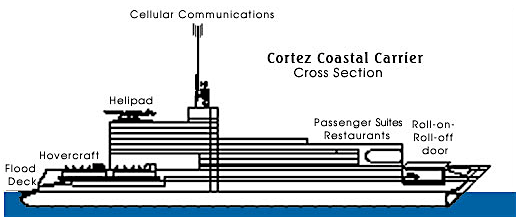 As development gets underway, freight and worker transport will be basic functions. A minimum number of Carriers will be needed to enable reliable service at multiple ports, but an initial group of five or six should be able to establish the business.
As development gets underway, freight and worker transport will be basic functions. A minimum number of Carriers will be needed to enable reliable service at multiple ports, but an initial group of five or six should be able to establish the business.
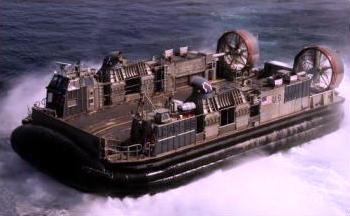 The CCC is designed to service shore communities via hovercraft and small boats. Helicopters can land aboard as well. Roll-on Roll-off of trucks, RVs, and passenger cans can be done at ports with appropriate facilities, and/or motor vehicles can be discharged via the hovercraft.
The CCC is designed to service shore communities via hovercraft and small boats. Helicopters can land aboard as well. Roll-on Roll-off of trucks, RVs, and passenger cans can be done at ports with appropriate facilities, and/or motor vehicles can be discharged via the hovercraft.
OTECortez
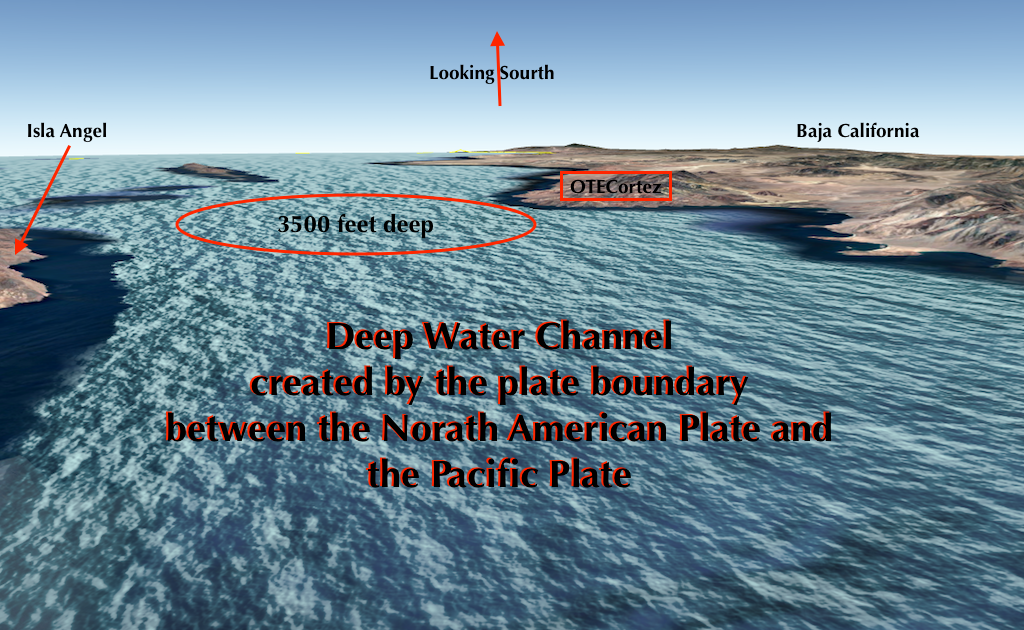 Ocean Thermal Electric Conversion in the Sea of Cortez can be located on the eastern coast of Baja or on the Isla Angel de la Guarda.
Ocean Thermal Electric Conversion in the Sea of Cortez can be located on the eastern coast of Baja or on the Isla Angel de la Guarda.
The OTECortez can provide three essential types of infrastructure support for populations on the shores of the Sea of Cortez. Electric power generators need nearby markets, and the Puerto Penasco EDD could buy all the power available. A power conduit from the island to could be dropped on the sea bed without difficulty. Freshwater for the Puerto Penasco area could be delivered via a pipeline from the OTEC and laid down simultaneously as the electric conduit. A land-based OTEC offers a great opportunity for aquaculture. Cool, nutrient-rich sea water is continually discharged from the power plant. If properly designed from the beginning, the water will course through the aqua culture runways before being returned to sea without additional inputs of energy for pumping. Protection from foraging sea birds through enclosures is one requirement, but the other major costs are subsidized by the OTEC. Researchers at Columbia University’s Lamont-De-Herty Geological Observatory said in a report: A one-hundred megawatt OTEC discharges enough condenser effluent to yield about 129,000 tons of shellfish annually and a similar quantity of carrageen-containing seaweed. If the wholesale cost of shellfish is 2.50 per pound, then the shellfish will gross 645 million dollars per year.
Once completed, OTECortez, unlike most infrastructure projects, will produce food, fresh water, and electricity to support operations, making this project exceptional. The combination of these three outputs from the OTECortez plant makes it financially feasible for the gulf, and the environmentally beneficial nature of its operation makes it ideal from a sustainable development perspective.
Geology of the Gulf
The Northern Gulf of California is quite shallow, as shown in the illustration above. The three colors of blue represent depths between one hundred, two hundred, and one thousand meters. It is approximately fifty kilometers from Puerto Penasco to reach a place where the sea is a depth of one hundred meters.
The high number of sunny days makes this shallow area a virtual solar collector and causes a strong convection current in the sea between Isla Angel de la Guarda and Baja as cooler deep water rushes in to replace warm water, which pushes south on the eastern side of the gulf.
Unique Geological Feature Offers the Means for Sustainable Economic Development
 The deep trench between the Isla Angel de la Guarda and the Baja peninsula is a rare site where geology, environment, and economics meet to offer a practical development opportunity. A three thousand-foot deep trench, the Canal de Ballenas, exists between the small island of Isla Angel de la Guarda and the Baja California coast.
The deep trench between the Isla Angel de la Guarda and the Baja peninsula is a rare site where geology, environment, and economics meet to offer a practical development opportunity. A three thousand-foot deep trench, the Canal de Ballenas, exists between the small island of Isla Angel de la Guarda and the Baja California coast.
Cold water is drawn into the gulf from the deep Pacific to replace expanding surface water that flows south from the Gulf of California’s upper basin. There is an ample supply of cold water to supply many OTEC plants on both shores. One special feature for this area is that the trench has a strong current flowing north that may require substantial testing and engineering to overcome turbulence around the intake pipes. The cost of developing this facility is mostly engineering a large complex of plumbing. Economics favors a larger facility because much of the electricity generated b the plant will be used to pump the coolant water, and the relative efficiency increases with size.
Research should define the optimum size plant for this area, and it may be possible to clone and improve the design in numerous locations on the Baja and the islands to distribute planning and other costs.
A brief description of OTEC Technology: Ocean Thermal Energy Conversion (OTEC)
OTEC, or ocean thermal energy conversion, is an energy technology that converts solar radiation to electric power. OTEC systems use the ocean’s natural thermal gradient—the fact that the ocean’s layers of water have different temperatures—to drive a power-producing cycle. As long as the temperature between the warm surface water and the cold deep water differs by about 20°C (36°F), an OTEC system can produce a significant amount of power. The oceans are thus a vast renewable resource with the potential to help us produce billions of watts of electric power. This potential is estimated to be about 1013 watts of baseload power generation, according to some experts. The cold, deep seawater used in the OTEC process is also rich in nutrients, and it can be used to culture both marine organisms and plant life near the shore or on land.
The Basic Process
There are basically three types of OTEC processes: closed-cycle, open-cycle, and hybrid-cycle.
In the closed-cycle system, heat transferred from the warm surface seawater causes a working fluid (such as ammonia, which boils at a temperature of about 78°F at atmospheric pressure), to turn to vapor. The expanding vapor drives a turbine attached to a generator which produces electricity. Cold seawater passing through a condenser containing the vaporized working fluid turns the vapor back into a liquid which is then recycled through the system.
Open-cycle OTEC uses the warm surface water itself as the working fluid. The water vaporizes in a near vacuum at surface water temperatures. The expanding vapor drives a low-pressure turbine attached to a generator which produces electricity. The vapor, which has lost its salt and is almost pure fresh water, is condensed back into a liquid by exposure to cold temperatures from deep ocean water. If the condenser keeps the vapor from direct contact with seawater, the condensed water can be used for drinking water, irrigation or aquaculture. A “direct contact” condenser produces more electricity, but the vapor is mixed with cold seawater, and the discharge water is salty. That mixture is returned to the ocean. The process is repeated with a continuous supply of warm surface seawater.
Hybrid systems use parts of both open- and closed-cycle systems to optimize the production of electricity and fresh water. See the Natural Energy Lab’s OTEC Fact Sheet.
For More Info:
Makai Ocean Engineering Makai has developed internationally recognized expertise in OTEC in the areas of commercial and pilot plant designs, overall technical and economic modeling, heat exchanger design and testing, cold water pipe design and deployment, environmental effects (hydro- and bio-plume modeling), and the power cable to shore.
Hawaii calls for OTEC power purchase proposals Natural Energy Laboratory of Hawaii Authority (NELHA) has launched a request for proposals for the purchase of power produced by the ocean thermal energy conversion (OTEC) plant system. The request for proposals covers the design, construction, implementation, operation, and maintenance of an OTEC system at the NELHA research campus.
Tethys is a research site with many technical papers dealing with the environmental impact of OTEC installations. A major environmental concern arises as cool, nutrient-rich water is withdrawn from the deep ocean and discharged higher in the water column. The effects of this cooler water and transport of nutrients on the ecosystem could vary but may affect the nearfield environment through temperature changes or increased biological growth.
Martinique OTEC Proposal Environmental impact assessment for an OTEC plant in Martinique Island
OTEC News Your in-depth source of information for Ocean Thermal Energy Conversion
MetaAmerica Project Strategy
Global Initiative for Sustainable Development
History will record the 21st Century as a Golden Age. Threads thousands of years in the making and from all culture’s ancient generations are now being woven into the tapestry of a single humanity. We who live in this century are the weavers that single cloth and our choices reach far beyond our time, for we are among the last generations to possess both the natural and created worlds at once. Not so long from now, only the created world will exist, and what we have done shall be its everlasting pattern.
This is our unique opportunity. Gathering the knowledge of all that has been, preserving, protecting, and honoring that which we do not yet understand equally with what we hold most dear. Our world is a treasure of riches invisible except to the eyes of future generations. We cannot judge what is expendable. Preservation of nature’s multi-billion-year-old legacy must be an unimpeachable requirement of our civilization’s long-term planning.
If we are to successfully overcome the obstacles imposed by expanding populations and economies, our commitment to public education and to understanding our role in nature must be greatly strengthened.
The MetaAmerica Project offers a clear step in this direction. It is a macro-development project embracing a broad range of social and technical systems designed to complement each another and forge an environmentally sustainable society. Systems that work harmoniously with the environment are needed for all world areas. Currently, though, most development systems depend on finite resources that limit their futures and create uncertainty and disincentives for long-term investment. A development system that overcomes these barriers will stimulate worldwide interest. This system should be regarded as a prototype that can be replicated in similar bioregions worldwide.
An Organization of Interested Citizens
The initial step is organizing people and information and identifying and accomplishing the tasks required to move the Project forward.
A Treaty will be Required.
The first official action must be an Agreement between the US and Mexico that enables the System to proceed. Such an agreement will need to delineate the rights and responsibilities of each nation. In theory, it would overlay a new Special Development District encompassing the lands surrounding the Sea of Cortez. Officers and administrators from each impacted agency would be drafted into the new District’s service and charged with enabling the Purposes of the Special Development District. In practice, this would occur as a cascade of legislation descending from national to state to county to city. The process of achieving a national agreement will involve all of these entities in the discussions.
Funding
The MetaAmerica Project can raise money by seeking sponsorships from nations that want to participate in the research bonanza created by the successful development of the Northern Gulf of California. National sponsorship will be required before the country’s business and education communities can join the Research Consortia. Business opportunities will abound as rights to employ the technologies in different regions are facilitated by the training of technologists from those areas as part of their Consortia participation.
A forty-year planning cycle provides ample opportunity to invest in new systems without economic hardship. This time frame is more easily understood as the duration of bonding authority to sell development bonds with twenty-year maturities.
First Investments
The scope of this project requires movement of epic proportions. National and International bureaucracies are involved and the time frame for decisions is extended since they require ample reporting from local entities impacted by the project before they will act. For this reason, the first efforts will need to be focused on parts of the project that can be accomplished more independently.
Two parts that complement each other are the OTECortez and the Coastal Carrier systems. While the OTEC is a large effort, its certain profitability has the ability to drive the project’s economic development from the outset.
Utilizing only the southern tip of the Isla Angel de la Guarda or the shore of Baja opposite it, it will be possible to create a Center for Research with the participation of higher education and corporate research departments and complemented by a full program promoting ecotourism to the site. A small port located on the east side of the island can be used by the first Coastal Carrier to transport people and equipment to and from the site.
The Coastal Carrier system can be built without significant shore facilities in place. Its extensive onboard facilities and hovercraft coastal access enable it to support development at its earliest stages. Early revenues can be generated by promoting it as a means to easily get from the Mexican coast to Baja and as a destination for Ecotourism. Advanced design utilizing electric power supplied by fuel cells will make the Carriers environmentally friendly to gulf waters and provide a market of hydrogen generated by the OTEC.
The OTECortez’s production of energy, aquaculture, and desalinated water are the magnets for revenues based on ecotourism, education, and commercial research. The OTEC project can be promoted as a showcase for Sustainable Technology to be developed through the combined efforts of Mexican and US interests, including:
- US and Mexican Universities
- US and Mexican Federal Research Agencies
- Commercial Research from International Business
OTECortez is the engine that can power the economic growth of the northern Gulf of California region. The unique challenges of its placement and construction can be turned into assets to attract the interest and financial participation of nations, educational institutions, international non-governmental organizations, and multinational corporations.
The MetaAmerica Project is a long-term effort to prototype a sustainable development strategy that can be emulated in other regions of the world. The five projects identified here represent an ambitious, but probably the minimum, list of what it will take to make such an initiative successful.
Not mentioned are all the innovations in administrative procedure and international law needed to enable an international project of this scope. It is obvious from the efforts in Europe that programs of this type are needed for North and South America to continue to evolve commercial and cultural relationships competitive with the European Union. The MetaAmerica Project is an opportunity to compete.